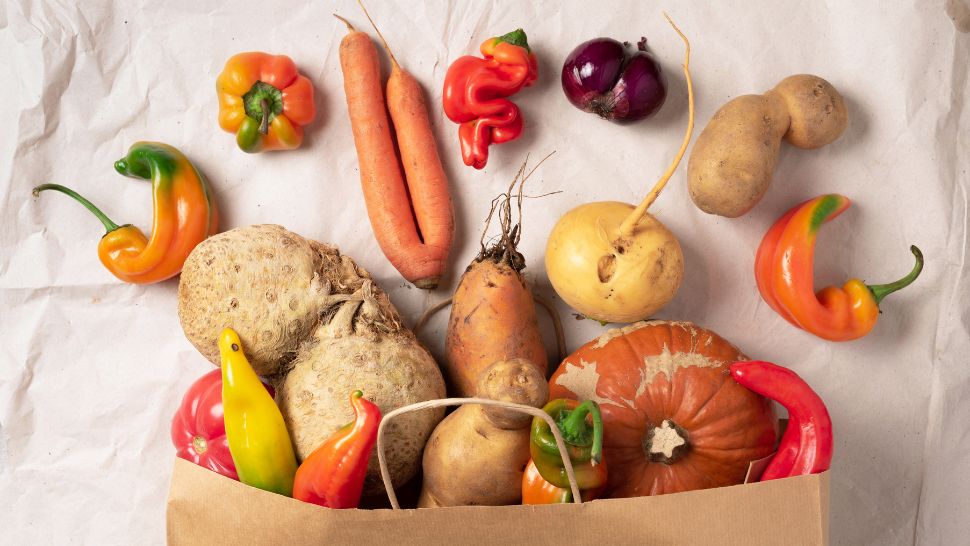
Eating sustainably isn’t just about the foods you choose—it’s also about how you approach your meals, where your ingredients come from, and how you minimize waste. Here are five playful and practical ways to eat more sustainably without compromising on flavor or fun:
- Go “Root to Stem” and Waste Nothing!
Have you ever thought about eating the entire plant? It’s a growing trend in sustainable kitchens: embracing the “root to stem” philosophy. Instead of tossing out beet greens, carrot tops, or broccoli stems, get creative with them! You can make chimichurri from radish greens, turn broccoli stems into crispy fries, or toss carrot tops into a salad for a zesty twist. Not only will you reduce food waste, but you’ll also discover new textures and flavors that make your meals more exciting. Plus, these often-overlooked bits are packed with nutrients!
So, next time you’re chopping veggies, think twice before throwing anything away—it might just be your new favorite ingredient. (Check out our guide on cooking with surprising edible plant parts for more inspiration!) - Eat “Ugly” Produce—Taste its Beauty (and Impact)
We’ve all seen those perfectly polished, symmetrical fruits and vegetables in the grocery store—but did you know that up to 40% of produce never makes it to the shelves because it doesn’t meet aesthetic standards? These “ugly” fruits and vegetables are often just as fresh, flavorful, and nutritious as their more photogenic counterparts. By buying or seeking out “imperfect” produce—whether from a local market, food co-op, or through “ugly” produce subscription boxes—you’re helping reduce food waste and supporting farmers who grow food that might otherwise go unsold. Plus, you’ll be eating seasonally and often saving money. Ugly apples? Bring them on! Wonky carrots? Perfect for your stir-fry! Choosing imperfect produce isn’t just a way to eat more sustainably—it’s also a chance to challenge the unrealistic beauty standards of our food system and embrace a more inclusive definition of what food can be. - Boost the Flavor of Meat….with Plants!
Elevate your meat-centric meals by incorporating plants. We’re talking about adding juiciness to your burger by mixing roasted mushrooms into your patties, adding texture to your meatballs with shredded zucchini, or combining pinto or black beans directly into your next taco or burrito filling for a creamy and more sustainable meal. Don’t like these combos? Use kale, bell peppers, tomatoes, or whatever your tastebuds are craving.Creating plant-rich meals gives you more opportunity to add color, umami, texture, and flavor while also reducing your consumption of animal proteins, which have a higher carbon footprint than plants. Pair these with your favorite sides and toppings for flavor bombs you won’t turn back from.
- Be a Strategic Meal Planner
Not all meals were created equally, and a (very) little planning can help you be more sustainable. Since we tend to plan meals around our protein source, aim to eat more plant-centric by making the foundation of your meal whole plant foods, such as beans, lentils, tofu, tempeh, and seitan, which are high in protein. If you’re a meat eater, make the remainder of your meals predominately seafood (sustainably sourced) or poultry since they have the lowest carbon footprint of our animal protein sources. Add in variety as needed with pork and occasionally mix in beef, if you crave it. Making small changes to the cadence that you eat different sources of protein is a simple way to help you become a more sustainable eater. Adding more plants, choosing less beef (our biggest carbon offender), and consuming the in-between proteins moderately can make a huge impact. - Host a “Zero-Waste Potluck” with Friends
Sharing a meal doesn’t have to mean a spendy trip to the grocery store. Instead, host a “zero-waste potluck” where everyone brings a dish made from (at least some) ingredients they have on hand. This encourages creativity and resourcefulness, while also inspiring sustainable recipe ideas. Maybe someone will bring a soup made from overripe vegetables, another will share a casserole made from leftover grains, or a dessert using fruits that are about to go bad—like these Waste-Free Whole Lemon Meringue Bars. Not only will you reduce food waste together, but you’ll also discover fun, inventive ways to upcycle ingredients. It’s a great excuse for a feel-good gathering that leaves you with a full belly and a lighter footprint!
Eating sustainably is about making small, enjoyable changes that add up to big benefits for the planet. Whether you’re experimenting with new ingredients or getting creative with leftovers, there are endless ways to make your meals more eco-friendly. So, why not make sustainability deliciously fun?